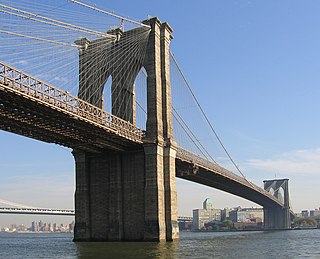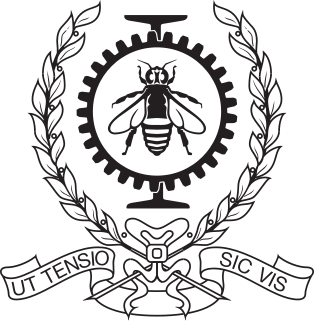
The Polytechnique Montréal is an engineering school affiliated with the Université de Montréal in Montreal, Quebec, Canada. It ranks first in Canada for the scope of its engineering research. It is occasionally referred to as Montreal Polytechnic, although in Quebec English its French name is more commonly used. The school offers graduate and postgraduate training, and is very active in research. Following tradition, new Bachelors of Engineering (B.Eng) graduating from the École Polytechnique receive an Iron Ring, during the Canadian Ritual of the Calling of an Engineer ceremony.

The New York University Tandon School of Engineering is the engineering and applied sciences school of New York University. Tandon is the second oldest private engineering and technology school in the United States. The school dates back to 1854 when its predecessor institutions, the University of the City of New York School of Civil Engineering and Architecture and the Brooklyn Collegiate and Polytechnic Institute, were founded. The school was renamed in 2015 in honor of NYU Trustees Chandrika and Ranjan Tandon following their donation of $100 million to the school.

Charles Joseph "Charlie" Camarda is an American engineer and a NASA astronaut who flew his first mission into space on board the Space Shuttle mission STS-114. He served as Senior Advisor for Engineering Development at NASA Langley Research Center.
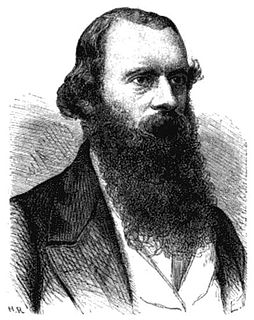
Josiah Latimer Clark FRAS, was an English electrical engineer, born in Great Marlow, Buckinghamshire.
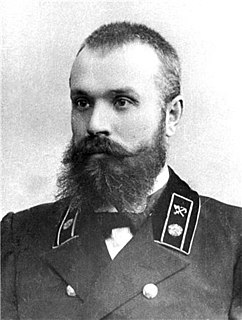
Professor Evgeny Oscarovich Paton was a Russian and Soviet engineer of Ukrainian descent who established the E. O. Paton Electric Welding Institute in Kiev. Paton was a people's deputy of the Supreme Soviet of the Soviet Union (1946–1953). He was the father of Borys Paton.
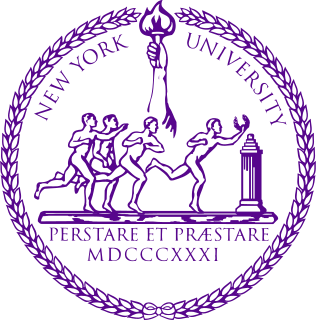
New York University (NYU) is a private research university based in New York City. Founded in 1831, NYU's historical campus is in Greenwich Village, Lower Manhattan. NYU also has degree-granting campuses in Abu Dhabi and Shanghai, and academic centers in Accra, Berlin, Buenos Aires, Florence, London, Los Angeles, Madrid, Paris, Prague, Sydney, Tel Aviv, and Washington, D.C.

The history of New York University begins in the early 19th century. A group of prominent New York City residents from the city's landed class of merchants, bankers, and traders established NYU on April 18, 1831. These New Yorkers believed the city needed a university designed for young men who would be admitted based on merit, not birthright or social class. Albert Gallatin, Secretary of the Treasury under Thomas Jefferson, described his motivation in a letter to a friend: "It appeared to me impossible to preserve our democratic institutions and the right of universal suffrage unless we could raise the standard of general education and the mind of the laboring classes nearer to a level with those born under more favorable circumstances." To the school's founders, the classical curriculum offered at American colonial colleges needed to be combined with a more modern and practical education. Educators in Paris, Vienna, and London were beginning to consider a new form of higher learning, where students began to focus not only on the classics and religion, but also modern languages, philosophy, history, political economy, mathematics, and physical science; so students might become merchants, bankers, lawyers, physicians, architects, and engineers. Although the new school would be non-denominational – unlike many American colonial colleges, which at the time offered classical educations centered on theology – the founding of NYU was also a reaction by evangelical Presbyterians to what they perceived as the Episcopalianism of Columbia College.

Jerry MacArthur Hultin was the United States Under Secretary of the Navy from 1997 to 2000. He was the president of the Polytechnic Institute of New York University from 2005 until 2012. He is currently the Chairman of the Global Futures Group, which advises cities, states and countries on best practices in smart city development.
Theodore (Ted) Scott Rappaport is an American electrical engineer and the David Lee/Ernst Weber Professor of Electrical and Computer Engineering at New York University Tandon School of Engineering and founding director of NYU Wireless. He was elected a Fellow of the National Academy of Inventors in 2018. He has written several textbooks, including Wireless Communications: Principles and Practice. He co-founded TSR Technologies, Inc. and Wireless Valley Communications, Inc., and founded academic wireless research centers at Virginia Tech, the University of Texas at Austin, and New York University. His 2013 paper, Millimeter Wave Mobile Communications for 5G Cellular: It Will Work! has been called a founding document of 5G millimeter wave. His textbook, Millimeter Wave Wireless Communications, appeared in 2014.
Eli M. Pearce was research professor at New York University Polytechnic School of Engineering and a past-president of the American Chemical Society. He received a B.S. degree in chemistry from Brooklyn College in 1949. Pearce earned a Ph.D. in chemistry from Polytechnic Institute of Brooklyn. He published more than 250 papers on his research. He designed fire-resistant polymers.
Eugene Fasullo was the Chief Engineer of Port Authority of New York and New Jersey. He is a member of National Academy of Engineering. He graduated with BS from Brooklyn Polytechnic Institute MS from University of Illinois. He was also a professor at NYU Poly.
Torunn Atteraas Garin was a Norwegian chemical engineer who worked on notable food projects. She worked on the artificial sweetener aspartame and was a national spokesperson for the product. She also developed nontoxic processes to create food colorings and remove caffeine from coffee. She graduated from the New York University Polytechnic School of Engineering in 1977.
Michael H. Kappaz was the Chairman and CEO of KM Group. He was also a vice president at Bechtel. He earned a B.S. in Industrial Engineering from Polytechnic University in Brooklyn and an MBA from Golden Gate University in San Francisco. He completed post-graduate work at Stanford University and the Wharton School of the University of Pennsylvania.
Kurt H. Becker is a physicist and entrepreneur. His research focuses on experimental atomic, chemical, and plasma physics. He is vice dean of research, innovation, and entrepreneurship at New York University Polytechnic School of Engineering. Becker holds seven patents regarding the generation and maintenance of atmospheric-pressure plasmas and their application.
Francisco de León from the New York University Tandon School of Engineering, Brooklyn, NY was named Fellow of the Institute of Electrical and Electronics Engineers (IEEE) in 2015 for contributions to transformer modeling for electromagnetic transient studies.
Clarence Floyd Hirshfeld was an American electrical, mechanical and consulting engineer, educator, chief of research for the Detroit Edison Co., now DTE Electric Company, author, and inventor, who was awarded the John Fritz Medal posthumous in 1940.
Joseph Albert Falcon was an American mechanical engineer, and business executive, who served as president of the American Society of Mechanical Engineers in 1992-93. Falcon was credited for his contributions in the energy field, which "encompassed nuclear power, geothermal facilities, fossil fuel-fired plants, alternative energy sources, and the geopolitics of oil and energy economics."
